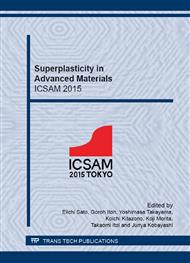[1]
T.G. Langdon, Twenty-five years of ultrafine-grained materials: Achieving exceptional properties through grain refinement, Acta Mater. 61 (2013) 51-59.
DOI: 10.1016/j.actamat.2013.08.018
Google Scholar
[2]
R.Z. Valiev, R.K. Islamgaliev, I.V. Alexandrov, Bulk nanostructured materials from severe plastic deformation, Prog. Mater. Sci. 45 (2000) 103-189.
DOI: 10.1016/s0079-6425(99)00007-9
Google Scholar
[3]
R.Z. Valiev, A.P. Zhilyaev, T.G. Langdon, Bulk Nanostructured Materials: Fundamentals and Applications, John Wiley & Sons: Hoboken, NJ, USA, (2014).
Google Scholar
[4]
E.O. Hall, The Deformation and Ageing of Mild Steel, Proc. Phys. Soc. B 64 (1951) 747–753.
Google Scholar
[5]
N.J. Petch, The cleavage strength of polycrystals, J. Iron. Steel Inst. 174 (1953) 25–28.
Google Scholar
[6]
I.A. Ovid'ko, T.G. Langdon, Enhanced ductility of nanocrystallien and ultra-fine grained metals, Rev. Adv. Mater. Sci. 30 (2012) 103-111.
Google Scholar
[7]
Y. Zhao, Y.T. Zhu, E.J. Lavernia, Strategies for improving tensile ductility of bulk nanostructured materials, Adv. Eng. Mater. 12 (2010) 769-778.
DOI: 10.1002/adem.200900335
Google Scholar
[8]
E. Ma, Eight routes to improve the tensile ductility of bulk nanostructured metals and alloys, JOM 4 (2006) 49-53.
DOI: 10.1007/s11837-006-0215-5
Google Scholar
[9]
Y.M. Wang, E. Ma, Three strategies to achieve uniform tensile elongation in a nanostructured metal, Acta Mater. 52 (2004) 1699-1709.
DOI: 10.1016/j.actamat.2003.12.022
Google Scholar
[10]
Y. Wang, M. Chen, F. Zhou, E. Ma, High tensile ductility in a nanostructured metal, Nature, 419 (2002) 912-915.
DOI: 10.1038/nature01133
Google Scholar
[11]
Y.H. Zhao, X.Z. Liao, S. Cheng, E. Ma, Y.T. Zhu, Simultaneously increasing the ductility and strength of nanostructured alloys, Adv. Mater. 18 (2006) 2280-2283.
DOI: 10.1002/adma.200600310
Google Scholar
[12]
Y.H. Zhao, J.F. Bingert, X.Z. Liao, B.Z. Cui, K. Han, A.V. Sergueeva, A.K. Mukherjee, R.Z. Valiev, T.G. Langdon, Y.T. Zhu, Simultaneously increasing the ductility and strength of ultra‐fine‐grained pure copper, Adv. Mater. 18 (2006) 2949-2953.
DOI: 10.1002/adma.200601472
Google Scholar
[13]
Y.H. Zhao, X.Z. Liao, Y.T. Zhu, Z. Horita, C. Xu, T.G. Langdon, Tailoring stacking fault energy for high ductility and high strength in ultrafine grained Cu and its alloy, Appl. Phys. Lett. 89 (2006) 121906.
DOI: 10.1063/1.2356310
Google Scholar
[14]
Y.H. Zhao, X.Z. Liao, Z. Horita, T.G. Langdon, Y.T. Zhu, Determining the optimal stacking fault energy for achieving high ductility in ultra-fine grained Cu-Zn alloys, Mater. Sci. Eng. A. 493 (2008) 123-129.
DOI: 10.1016/j.msea.2007.11.074
Google Scholar
[15]
R.Z. Valiev, M. Yu. Murashkin, A. Kilmametov, B. Straumal, N.Q. Chinh, T.G. Langdon, Unusual super-ductility at room temperature in an ultra-fine grained aluminium alloy. J. Mater. Sci. 45 (2010) 4718-4724.
DOI: 10.1007/s10853-010-4588-z
Google Scholar
[16]
K. Yang, Yu. Ivanisenko, A. Caron, A. Chuvilin, L. Kurmanaeva, T. Scherer, R.Z. Valiev, H.J. Fecht, Mechanical behavior and in situ observation of shear bands in ultra-fine grained Pd and Pd-Ag alloys, Acta Mater. 58 (2010) 967-978.
DOI: 10.1016/j.actamat.2009.10.013
Google Scholar
[17]
R.Z. Valiev, T.G. Langdon, Principles of equal channel angular pressing as a processing tool for grain refinement, Prog. Mater. Sci. 51 (2006) 881-981.
DOI: 10.1016/j.pmatsci.2006.02.003
Google Scholar
[18]
S. Komura, Z. Horita, M. Nemoto, T.G. Langdon, Influence of stacking fault energy on microstructural development in equal-channel angular pressing, J. Mater. Res. 14 (1999) 4044-4050.
DOI: 10.1557/jmr.1999.0546
Google Scholar
[19]
F.H. Dalla Torre, E.V. Pereloma, C.H.J. Davies, Strain hardening behaviour and deformation kinetics of Cu deformed by equal channel angular extrusion from 1 to 16 passes, Acta Mater. 54 (2006) 1135-1146.
DOI: 10.1016/j.actamat.2005.10.041
Google Scholar
[20]
M. Murashkin, I. Sabirov, V. Kazykhanov, E. Bobruk, R.Z. Valiev, Enhanced mechanical properties and electrical conductivity in ultrafine-grained Al alloy processed via ECAP-PC. J. Mater. Sci. 48 (2013) 4501-4509.
DOI: 10.1007/s10853-013-7279-8
Google Scholar
[21]
E.C. Moreno-Valle, M.A. Monclus, J.M. Molina-Aldareguia, N. Enikeev, I. Sabirov, Biaxial deformation behavior and enhanced formability of ultrafine-grained pure copper. Metall. Mater. Trans. A. 44 (2013) 2399-2408.
DOI: 10.1007/s11661-012-1576-8
Google Scholar


